Comprehensive Analysis of Supply Chain Planning, Task 2 Solution
VerifiedAdded on 2023/06/17
|10
|3169
|471
Report
AI Summary
This report provides a comprehensive analysis of supply chain planning, modelling, and analytics, focusing on quantitative and qualitative approaches to supply chain operations. It delves into aggregate and hierarchical planning and control, examining the factors influencing aggregate planning and different planning strategies. The report also evaluates the implementation of ERP systems in business operations, outlining the various stages and best practices for successful implementation. Furthermore, it explores the use of simulation techniques and big data analytical techniques in key areas of supply chain management, highlighting their role in optimizing logistics and decision-making. This document, contributed by a student, is available on Desklib, a platform offering study tools and resources for students.

SUPPLY CHAIN
PLANNING
MODELLING AND
ANALYTICS(Task 2)
PLANNING
MODELLING AND
ANALYTICS(Task 2)
Paraphrase This Document
Need a fresh take? Get an instant paraphrase of this document with our AI Paraphraser
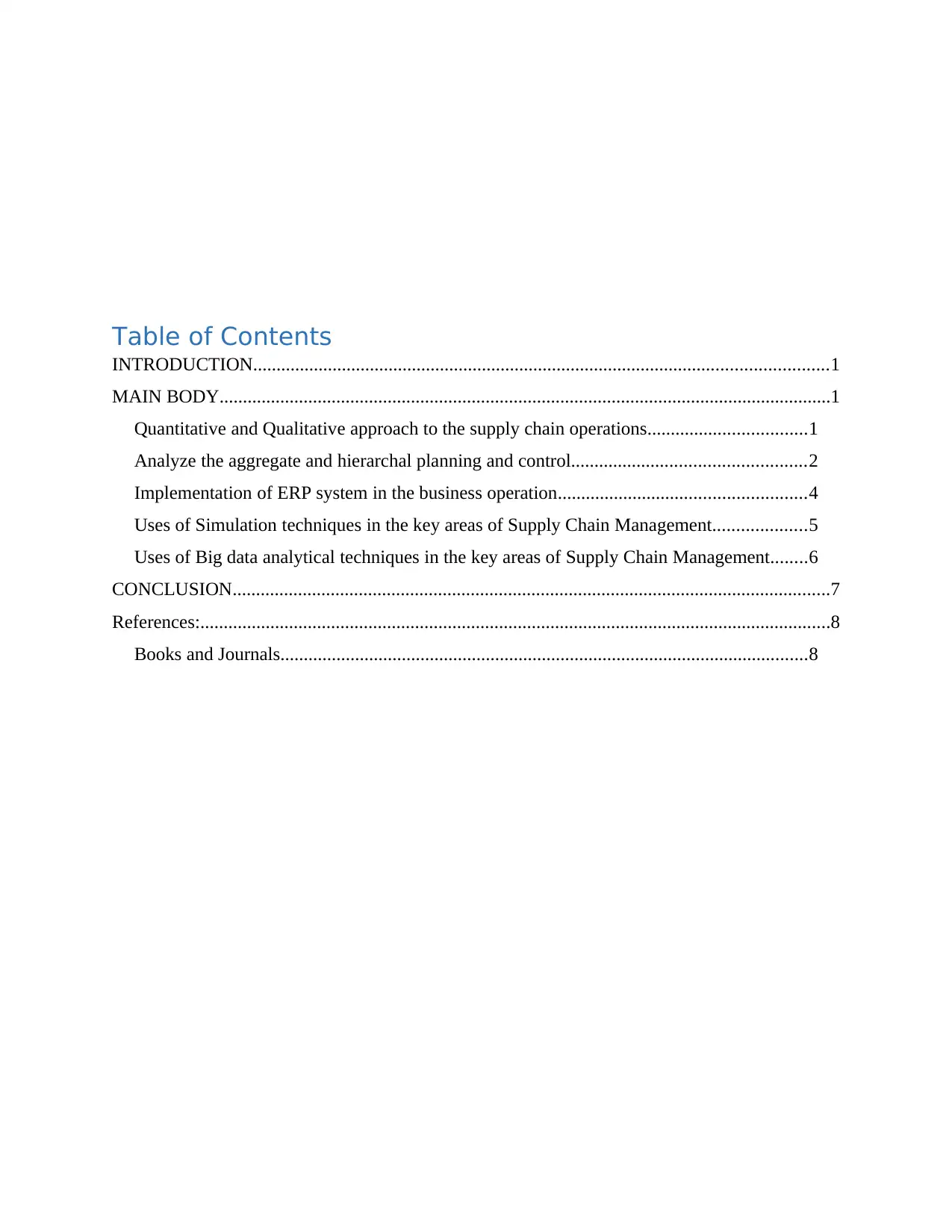
Table of Contents
INTRODUCTION...........................................................................................................................1
MAIN BODY...................................................................................................................................1
Quantitative and Qualitative approach to the supply chain operations..................................1
Analyze the aggregate and hierarchal planning and control..................................................2
Implementation of ERP system in the business operation.....................................................4
Uses of Simulation techniques in the key areas of Supply Chain Management....................5
Uses of Big data analytical techniques in the key areas of Supply Chain Management........6
CONCLUSION................................................................................................................................7
References:.......................................................................................................................................8
Books and Journals.................................................................................................................8
INTRODUCTION...........................................................................................................................1
MAIN BODY...................................................................................................................................1
Quantitative and Qualitative approach to the supply chain operations..................................1
Analyze the aggregate and hierarchal planning and control..................................................2
Implementation of ERP system in the business operation.....................................................4
Uses of Simulation techniques in the key areas of Supply Chain Management....................5
Uses of Big data analytical techniques in the key areas of Supply Chain Management........6
CONCLUSION................................................................................................................................7
References:.......................................................................................................................................8
Books and Journals.................................................................................................................8
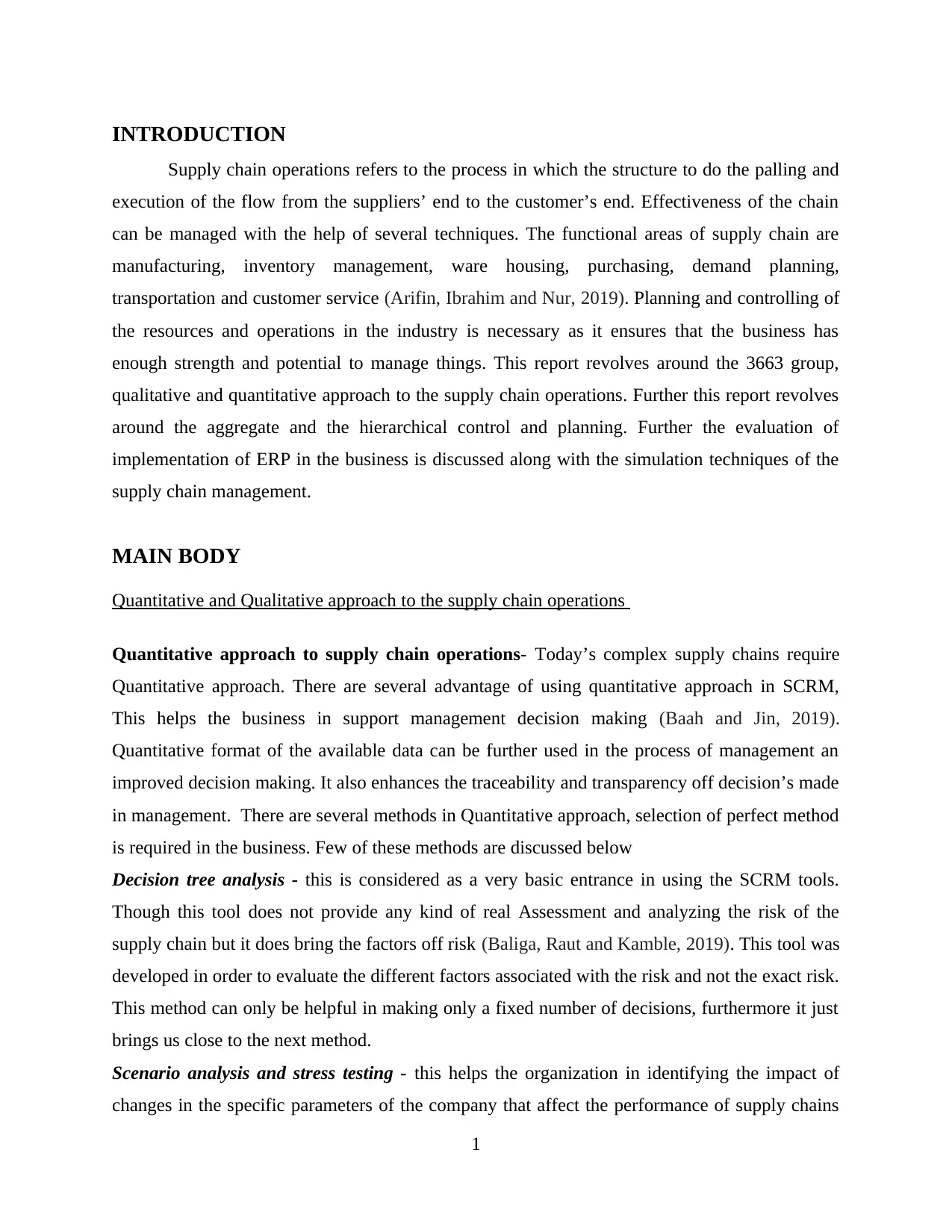
INTRODUCTION
Supply chain operations refers to the process in which the structure to do the palling and
execution of the flow from the suppliers’ end to the customer’s end. Effectiveness of the chain
can be managed with the help of several techniques. The functional areas of supply chain are
manufacturing, inventory management, ware housing, purchasing, demand planning,
transportation and customer service (Arifin, Ibrahim and Nur, 2019). Planning and controlling of
the resources and operations in the industry is necessary as it ensures that the business has
enough strength and potential to manage things. This report revolves around the 3663 group,
qualitative and quantitative approach to the supply chain operations. Further this report revolves
around the aggregate and the hierarchical control and planning. Further the evaluation of
implementation of ERP in the business is discussed along with the simulation techniques of the
supply chain management.
MAIN BODY
Quantitative and Qualitative approach to the supply chain operations
Quantitative approach to supply chain operations- Today’s complex supply chains require
Quantitative approach. There are several advantage of using quantitative approach in SCRM,
This helps the business in support management decision making (Baah and Jin, 2019).
Quantitative format of the available data can be further used in the process of management an
improved decision making. It also enhances the traceability and transparency off decision’s made
in management. There are several methods in Quantitative approach, selection of perfect method
is required in the business. Few of these methods are discussed below
Decision tree analysis - this is considered as a very basic entrance in using the SCRM tools.
Though this tool does not provide any kind of real Assessment and analyzing the risk of the
supply chain but it does bring the factors off risk (Baliga, Raut and Kamble, 2019). This tool was
developed in order to evaluate the different factors associated with the risk and not the exact risk.
This method can only be helpful in making only a fixed number of decisions, furthermore it just
brings us close to the next method.
Scenario analysis and stress testing - this helps the organization in identifying the impact of
changes in the specific parameters of the company that affect the performance of supply chains
1
Supply chain operations refers to the process in which the structure to do the palling and
execution of the flow from the suppliers’ end to the customer’s end. Effectiveness of the chain
can be managed with the help of several techniques. The functional areas of supply chain are
manufacturing, inventory management, ware housing, purchasing, demand planning,
transportation and customer service (Arifin, Ibrahim and Nur, 2019). Planning and controlling of
the resources and operations in the industry is necessary as it ensures that the business has
enough strength and potential to manage things. This report revolves around the 3663 group,
qualitative and quantitative approach to the supply chain operations. Further this report revolves
around the aggregate and the hierarchical control and planning. Further the evaluation of
implementation of ERP in the business is discussed along with the simulation techniques of the
supply chain management.
MAIN BODY
Quantitative and Qualitative approach to the supply chain operations
Quantitative approach to supply chain operations- Today’s complex supply chains require
Quantitative approach. There are several advantage of using quantitative approach in SCRM,
This helps the business in support management decision making (Baah and Jin, 2019).
Quantitative format of the available data can be further used in the process of management an
improved decision making. It also enhances the traceability and transparency off decision’s made
in management. There are several methods in Quantitative approach, selection of perfect method
is required in the business. Few of these methods are discussed below
Decision tree analysis - this is considered as a very basic entrance in using the SCRM tools.
Though this tool does not provide any kind of real Assessment and analyzing the risk of the
supply chain but it does bring the factors off risk (Baliga, Raut and Kamble, 2019). This tool was
developed in order to evaluate the different factors associated with the risk and not the exact risk.
This method can only be helpful in making only a fixed number of decisions, furthermore it just
brings us close to the next method.
Scenario analysis and stress testing - this helps the organization in identifying the impact of
changes in the specific parameters of the company that affect the performance of supply chains
1
⊘ This is a preview!⊘
Do you want full access?
Subscribe today to unlock all pages.

Trusted by 1+ million students worldwide
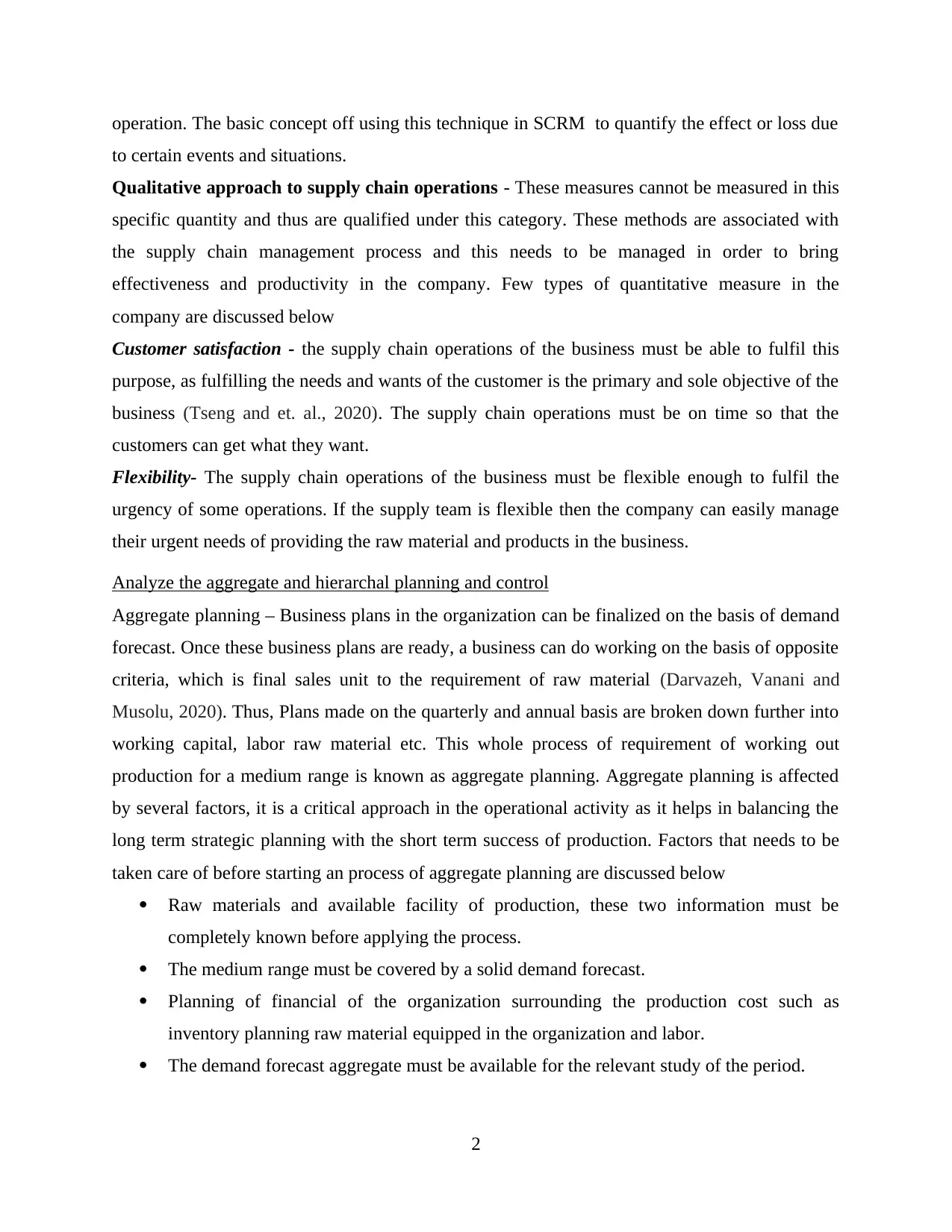
operation. The basic concept off using this technique in SCRM to quantify the effect or loss due
to certain events and situations.
Qualitative approach to supply chain operations - These measures cannot be measured in this
specific quantity and thus are qualified under this category. These methods are associated with
the supply chain management process and this needs to be managed in order to bring
effectiveness and productivity in the company. Few types of quantitative measure in the
company are discussed below
Customer satisfaction - the supply chain operations of the business must be able to fulfil this
purpose, as fulfilling the needs and wants of the customer is the primary and sole objective of the
business (Tseng and et. al., 2020). The supply chain operations must be on time so that the
customers can get what they want.
Flexibility- The supply chain operations of the business must be flexible enough to fulfil the
urgency of some operations. If the supply team is flexible then the company can easily manage
their urgent needs of providing the raw material and products in the business.
Analyze the aggregate and hierarchal planning and control
Aggregate planning – Business plans in the organization can be finalized on the basis of demand
forecast. Once these business plans are ready, a business can do working on the basis of opposite
criteria, which is final sales unit to the requirement of raw material (Darvazeh, Vanani and
Musolu, 2020). Thus, Plans made on the quarterly and annual basis are broken down further into
working capital, labor raw material etc. This whole process of requirement of working out
production for a medium range is known as aggregate planning. Aggregate planning is affected
by several factors, it is a critical approach in the operational activity as it helps in balancing the
long term strategic planning with the short term success of production. Factors that needs to be
taken care of before starting an process of aggregate planning are discussed below
Raw materials and available facility of production, these two information must be
completely known before applying the process.
The medium range must be covered by a solid demand forecast.
Planning of financial of the organization surrounding the production cost such as
inventory planning raw material equipped in the organization and labor.
The demand forecast aggregate must be available for the relevant study of the period.
2
to certain events and situations.
Qualitative approach to supply chain operations - These measures cannot be measured in this
specific quantity and thus are qualified under this category. These methods are associated with
the supply chain management process and this needs to be managed in order to bring
effectiveness and productivity in the company. Few types of quantitative measure in the
company are discussed below
Customer satisfaction - the supply chain operations of the business must be able to fulfil this
purpose, as fulfilling the needs and wants of the customer is the primary and sole objective of the
business (Tseng and et. al., 2020). The supply chain operations must be on time so that the
customers can get what they want.
Flexibility- The supply chain operations of the business must be flexible enough to fulfil the
urgency of some operations. If the supply team is flexible then the company can easily manage
their urgent needs of providing the raw material and products in the business.
Analyze the aggregate and hierarchal planning and control
Aggregate planning – Business plans in the organization can be finalized on the basis of demand
forecast. Once these business plans are ready, a business can do working on the basis of opposite
criteria, which is final sales unit to the requirement of raw material (Darvazeh, Vanani and
Musolu, 2020). Thus, Plans made on the quarterly and annual basis are broken down further into
working capital, labor raw material etc. This whole process of requirement of working out
production for a medium range is known as aggregate planning. Aggregate planning is affected
by several factors, it is a critical approach in the operational activity as it helps in balancing the
long term strategic planning with the short term success of production. Factors that needs to be
taken care of before starting an process of aggregate planning are discussed below
Raw materials and available facility of production, these two information must be
completely known before applying the process.
The medium range must be covered by a solid demand forecast.
Planning of financial of the organization surrounding the production cost such as
inventory planning raw material equipped in the organization and labor.
The demand forecast aggregate must be available for the relevant study of the period.
2
Paraphrase This Document
Need a fresh take? Get an instant paraphrase of this document with our AI Paraphraser
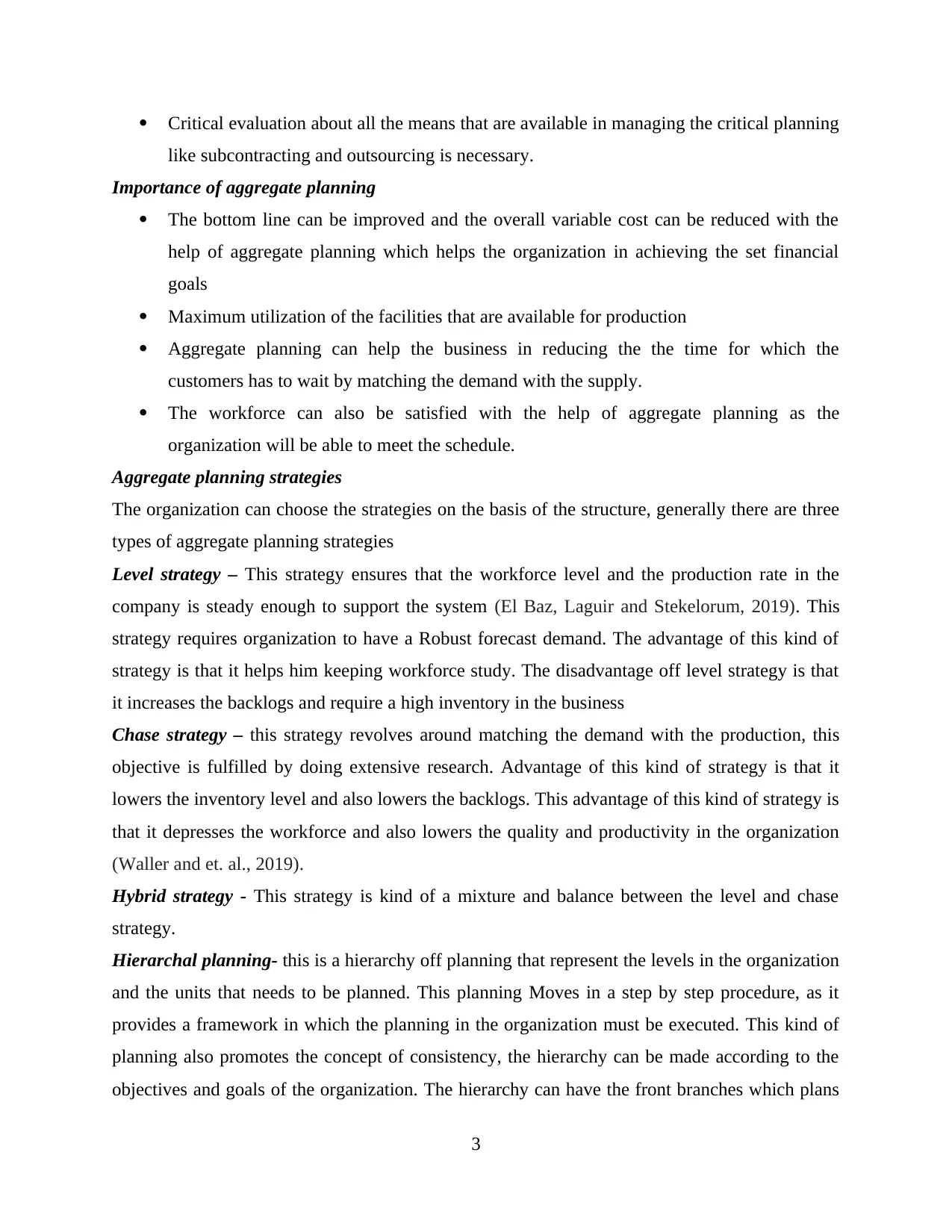
Critical evaluation about all the means that are available in managing the critical planning
like subcontracting and outsourcing is necessary.
Importance of aggregate planning
The bottom line can be improved and the overall variable cost can be reduced with the
help of aggregate planning which helps the organization in achieving the set financial
goals
Maximum utilization of the facilities that are available for production
Aggregate planning can help the business in reducing the the time for which the
customers has to wait by matching the demand with the supply.
The workforce can also be satisfied with the help of aggregate planning as the
organization will be able to meet the schedule.
Aggregate planning strategies
The organization can choose the strategies on the basis of the structure, generally there are three
types of aggregate planning strategies
Level strategy – This strategy ensures that the workforce level and the production rate in the
company is steady enough to support the system (El Baz, Laguir and Stekelorum, 2019). This
strategy requires organization to have a Robust forecast demand. The advantage of this kind of
strategy is that it helps him keeping workforce study. The disadvantage off level strategy is that
it increases the backlogs and require a high inventory in the business
Chase strategy – this strategy revolves around matching the demand with the production, this
objective is fulfilled by doing extensive research. Advantage of this kind of strategy is that it
lowers the inventory level and also lowers the backlogs. This advantage of this kind of strategy is
that it depresses the workforce and also lowers the quality and productivity in the organization
(Waller and et. al., 2019).
Hybrid strategy - This strategy is kind of a mixture and balance between the level and chase
strategy.
Hierarchal planning- this is a hierarchy off planning that represent the levels in the organization
and the units that needs to be planned. This planning Moves in a step by step procedure, as it
provides a framework in which the planning in the organization must be executed. This kind of
planning also promotes the concept of consistency, the hierarchy can be made according to the
objectives and goals of the organization. The hierarchy can have the front branches which plans
3
like subcontracting and outsourcing is necessary.
Importance of aggregate planning
The bottom line can be improved and the overall variable cost can be reduced with the
help of aggregate planning which helps the organization in achieving the set financial
goals
Maximum utilization of the facilities that are available for production
Aggregate planning can help the business in reducing the the time for which the
customers has to wait by matching the demand with the supply.
The workforce can also be satisfied with the help of aggregate planning as the
organization will be able to meet the schedule.
Aggregate planning strategies
The organization can choose the strategies on the basis of the structure, generally there are three
types of aggregate planning strategies
Level strategy – This strategy ensures that the workforce level and the production rate in the
company is steady enough to support the system (El Baz, Laguir and Stekelorum, 2019). This
strategy requires organization to have a Robust forecast demand. The advantage of this kind of
strategy is that it helps him keeping workforce study. The disadvantage off level strategy is that
it increases the backlogs and require a high inventory in the business
Chase strategy – this strategy revolves around matching the demand with the production, this
objective is fulfilled by doing extensive research. Advantage of this kind of strategy is that it
lowers the inventory level and also lowers the backlogs. This advantage of this kind of strategy is
that it depresses the workforce and also lowers the quality and productivity in the organization
(Waller and et. al., 2019).
Hybrid strategy - This strategy is kind of a mixture and balance between the level and chase
strategy.
Hierarchal planning- this is a hierarchy off planning that represent the levels in the organization
and the units that needs to be planned. This planning Moves in a step by step procedure, as it
provides a framework in which the planning in the organization must be executed. This kind of
planning also promotes the concept of consistency, the hierarchy can be made according to the
objectives and goals of the organization. The hierarchy can have the front branches which plans
3
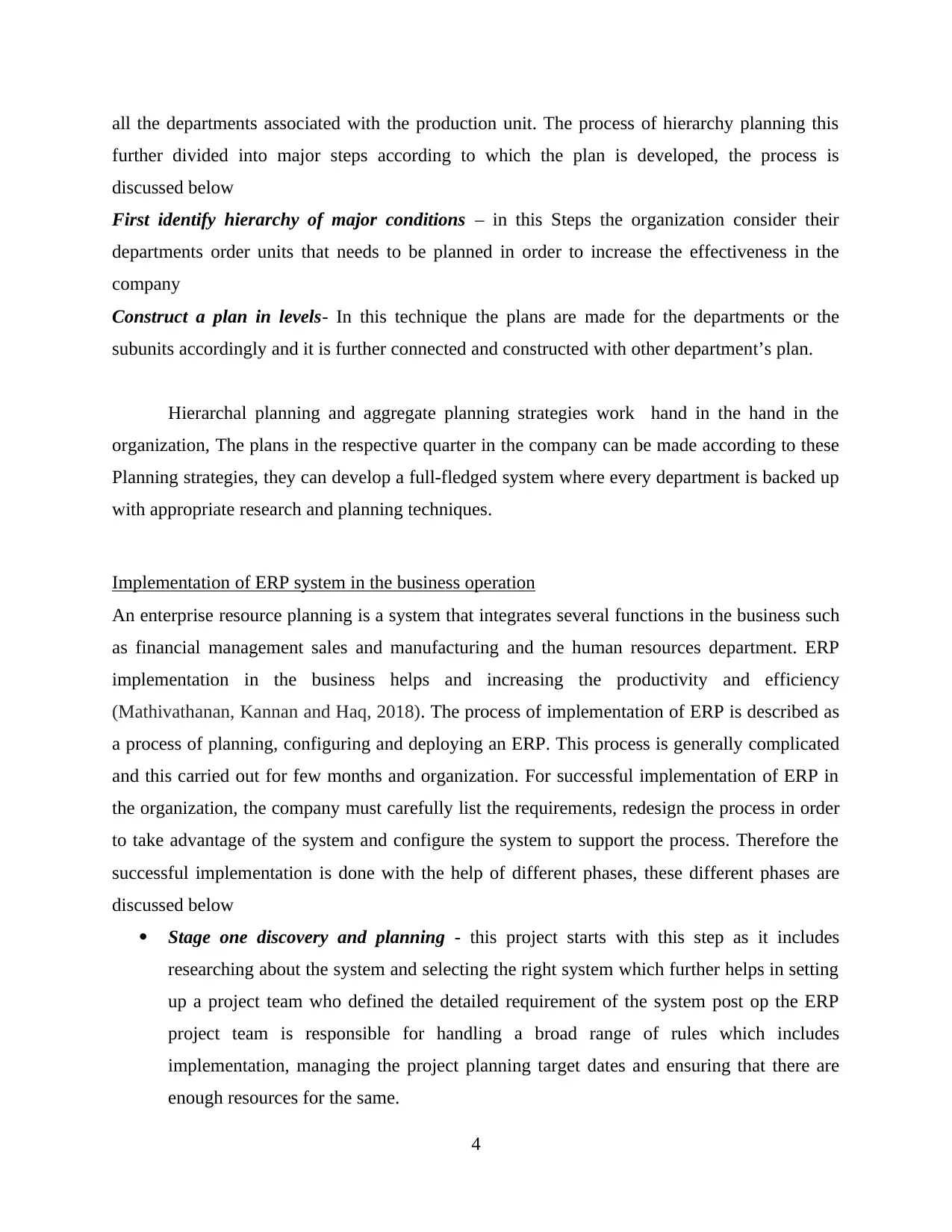
all the departments associated with the production unit. The process of hierarchy planning this
further divided into major steps according to which the plan is developed, the process is
discussed below
First identify hierarchy of major conditions – in this Steps the organization consider their
departments order units that needs to be planned in order to increase the effectiveness in the
company
Construct a plan in levels- In this technique the plans are made for the departments or the
subunits accordingly and it is further connected and constructed with other department’s plan.
Hierarchal planning and aggregate planning strategies work hand in the hand in the
organization, The plans in the respective quarter in the company can be made according to these
Planning strategies, they can develop a full-fledged system where every department is backed up
with appropriate research and planning techniques.
Implementation of ERP system in the business operation
An enterprise resource planning is a system that integrates several functions in the business such
as financial management sales and manufacturing and the human resources department. ERP
implementation in the business helps and increasing the productivity and efficiency
(Mathivathanan, Kannan and Haq, 2018). The process of implementation of ERP is described as
a process of planning, configuring and deploying an ERP. This process is generally complicated
and this carried out for few months and organization. For successful implementation of ERP in
the organization, the company must carefully list the requirements, redesign the process in order
to take advantage of the system and configure the system to support the process. Therefore the
successful implementation is done with the help of different phases, these different phases are
discussed below
Stage one discovery and planning - this project starts with this step as it includes
researching about the system and selecting the right system which further helps in setting
up a project team who defined the detailed requirement of the system post op the ERP
project team is responsible for handling a broad range of rules which includes
implementation, managing the project planning target dates and ensuring that there are
enough resources for the same.
4
further divided into major steps according to which the plan is developed, the process is
discussed below
First identify hierarchy of major conditions – in this Steps the organization consider their
departments order units that needs to be planned in order to increase the effectiveness in the
company
Construct a plan in levels- In this technique the plans are made for the departments or the
subunits accordingly and it is further connected and constructed with other department’s plan.
Hierarchal planning and aggregate planning strategies work hand in the hand in the
organization, The plans in the respective quarter in the company can be made according to these
Planning strategies, they can develop a full-fledged system where every department is backed up
with appropriate research and planning techniques.
Implementation of ERP system in the business operation
An enterprise resource planning is a system that integrates several functions in the business such
as financial management sales and manufacturing and the human resources department. ERP
implementation in the business helps and increasing the productivity and efficiency
(Mathivathanan, Kannan and Haq, 2018). The process of implementation of ERP is described as
a process of planning, configuring and deploying an ERP. This process is generally complicated
and this carried out for few months and organization. For successful implementation of ERP in
the organization, the company must carefully list the requirements, redesign the process in order
to take advantage of the system and configure the system to support the process. Therefore the
successful implementation is done with the help of different phases, these different phases are
discussed below
Stage one discovery and planning - this project starts with this step as it includes
researching about the system and selecting the right system which further helps in setting
up a project team who defined the detailed requirement of the system post op the ERP
project team is responsible for handling a broad range of rules which includes
implementation, managing the project planning target dates and ensuring that there are
enough resources for the same.
4
⊘ This is a preview!⊘
Do you want full access?
Subscribe today to unlock all pages.

Trusted by 1+ million students worldwide
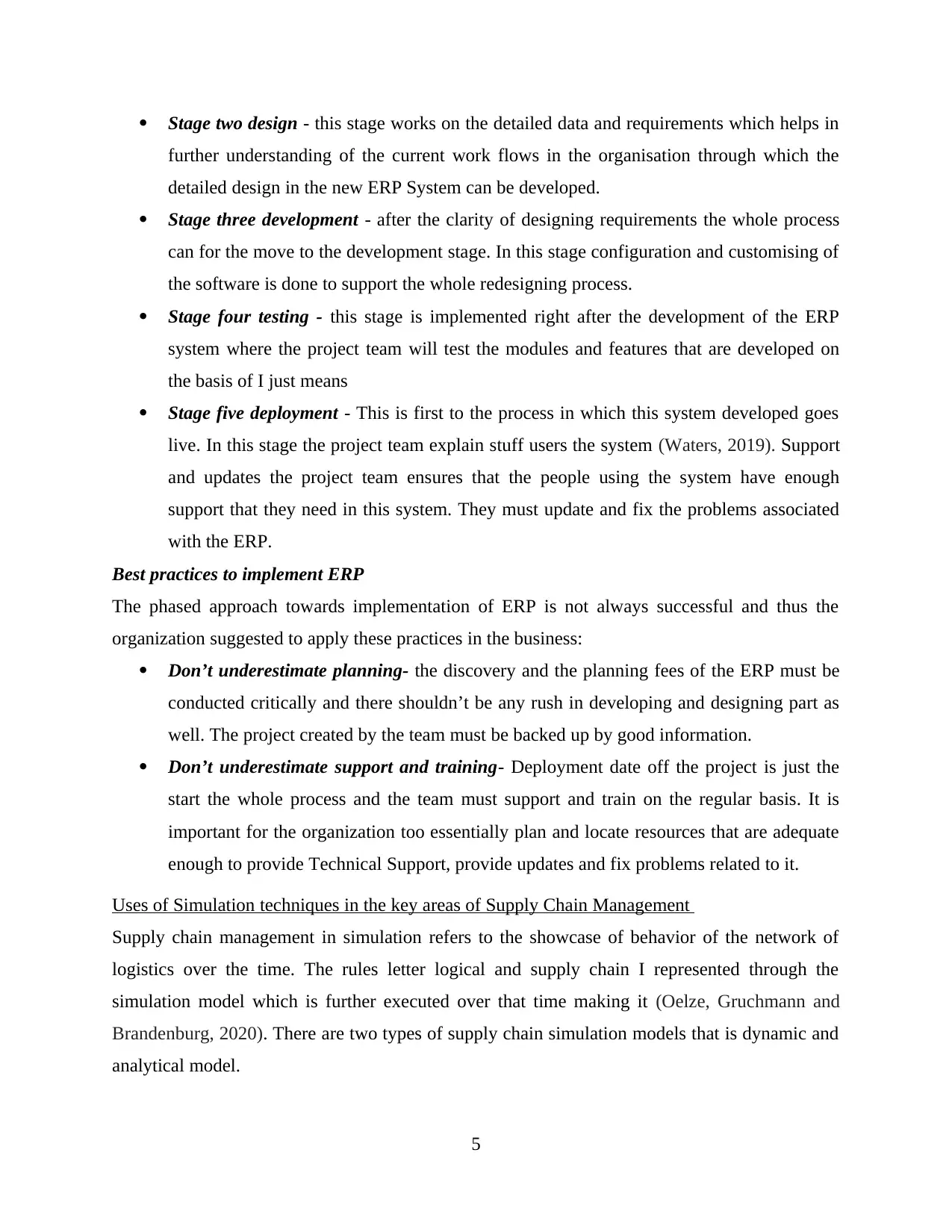
Stage two design - this stage works on the detailed data and requirements which helps in
further understanding of the current work flows in the organisation through which the
detailed design in the new ERP System can be developed.
Stage three development - after the clarity of designing requirements the whole process
can for the move to the development stage. In this stage configuration and customising of
the software is done to support the whole redesigning process.
Stage four testing - this stage is implemented right after the development of the ERP
system where the project team will test the modules and features that are developed on
the basis of I just means
Stage five deployment - This is first to the process in which this system developed goes
live. In this stage the project team explain stuff users the system (Waters, 2019). Support
and updates the project team ensures that the people using the system have enough
support that they need in this system. They must update and fix the problems associated
with the ERP.
Best practices to implement ERP
The phased approach towards implementation of ERP is not always successful and thus the
organization suggested to apply these practices in the business:
Don’t underestimate planning- the discovery and the planning fees of the ERP must be
conducted critically and there shouldn’t be any rush in developing and designing part as
well. The project created by the team must be backed up by good information.
Don’t underestimate support and training- Deployment date off the project is just the
start the whole process and the team must support and train on the regular basis. It is
important for the organization too essentially plan and locate resources that are adequate
enough to provide Technical Support, provide updates and fix problems related to it.
Uses of Simulation techniques in the key areas of Supply Chain Management
Supply chain management in simulation refers to the showcase of behavior of the network of
logistics over the time. The rules letter logical and supply chain I represented through the
simulation model which is further executed over that time making it (Oelze, Gruchmann and
Brandenburg, 2020). There are two types of supply chain simulation models that is dynamic and
analytical model.
5
further understanding of the current work flows in the organisation through which the
detailed design in the new ERP System can be developed.
Stage three development - after the clarity of designing requirements the whole process
can for the move to the development stage. In this stage configuration and customising of
the software is done to support the whole redesigning process.
Stage four testing - this stage is implemented right after the development of the ERP
system where the project team will test the modules and features that are developed on
the basis of I just means
Stage five deployment - This is first to the process in which this system developed goes
live. In this stage the project team explain stuff users the system (Waters, 2019). Support
and updates the project team ensures that the people using the system have enough
support that they need in this system. They must update and fix the problems associated
with the ERP.
Best practices to implement ERP
The phased approach towards implementation of ERP is not always successful and thus the
organization suggested to apply these practices in the business:
Don’t underestimate planning- the discovery and the planning fees of the ERP must be
conducted critically and there shouldn’t be any rush in developing and designing part as
well. The project created by the team must be backed up by good information.
Don’t underestimate support and training- Deployment date off the project is just the
start the whole process and the team must support and train on the regular basis. It is
important for the organization too essentially plan and locate resources that are adequate
enough to provide Technical Support, provide updates and fix problems related to it.
Uses of Simulation techniques in the key areas of Supply Chain Management
Supply chain management in simulation refers to the showcase of behavior of the network of
logistics over the time. The rules letter logical and supply chain I represented through the
simulation model which is further executed over that time making it (Oelze, Gruchmann and
Brandenburg, 2020). There are two types of supply chain simulation models that is dynamic and
analytical model.
5
Paraphrase This Document
Need a fresh take? Get an instant paraphrase of this document with our AI Paraphraser
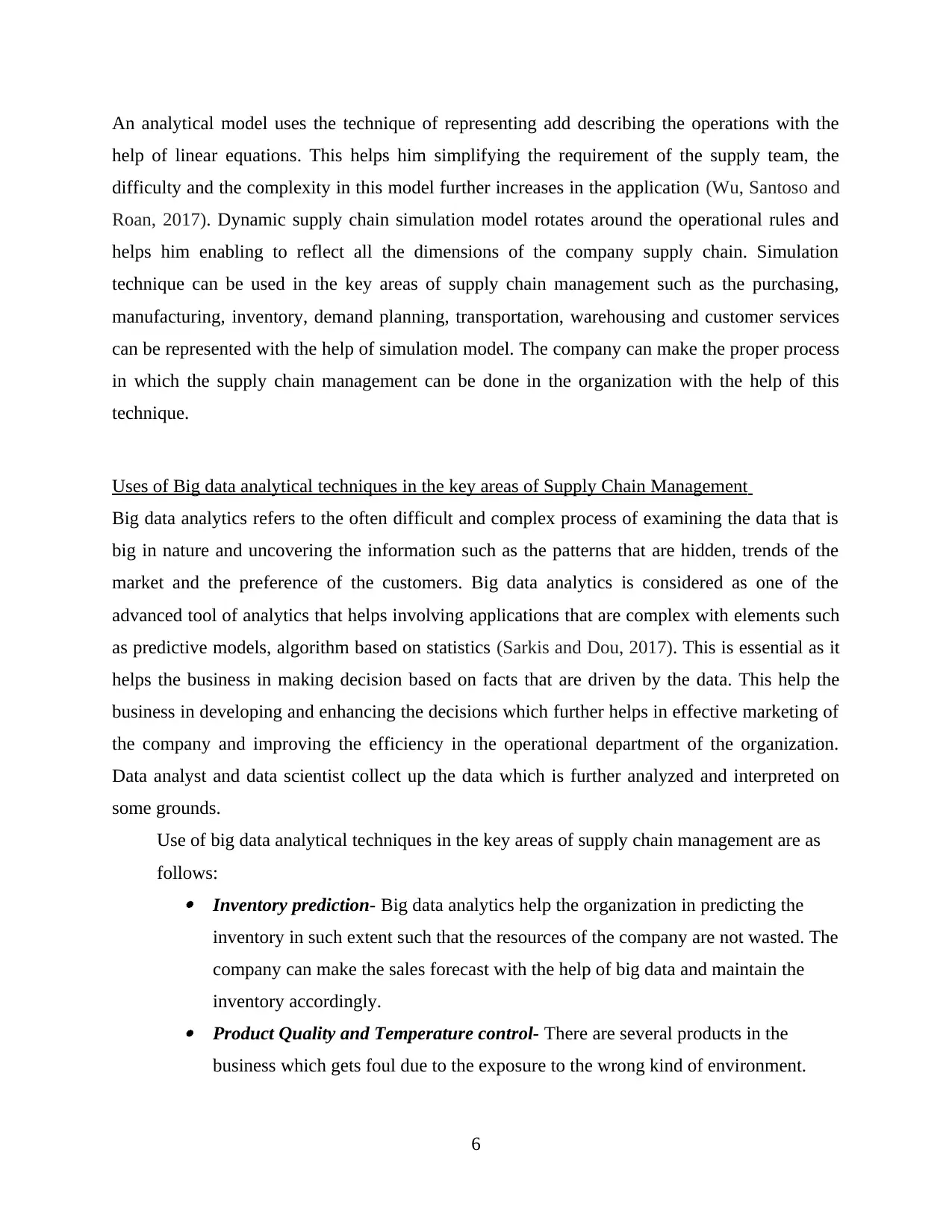
An analytical model uses the technique of representing add describing the operations with the
help of linear equations. This helps him simplifying the requirement of the supply team, the
difficulty and the complexity in this model further increases in the application (Wu, Santoso and
Roan, 2017). Dynamic supply chain simulation model rotates around the operational rules and
helps him enabling to reflect all the dimensions of the company supply chain. Simulation
technique can be used in the key areas of supply chain management such as the purchasing,
manufacturing, inventory, demand planning, transportation, warehousing and customer services
can be represented with the help of simulation model. The company can make the proper process
in which the supply chain management can be done in the organization with the help of this
technique.
Uses of Big data analytical techniques in the key areas of Supply Chain Management
Big data analytics refers to the often difficult and complex process of examining the data that is
big in nature and uncovering the information such as the patterns that are hidden, trends of the
market and the preference of the customers. Big data analytics is considered as one of the
advanced tool of analytics that helps involving applications that are complex with elements such
as predictive models, algorithm based on statistics (Sarkis and Dou, 2017). This is essential as it
helps the business in making decision based on facts that are driven by the data. This help the
business in developing and enhancing the decisions which further helps in effective marketing of
the company and improving the efficiency in the operational department of the organization.
Data analyst and data scientist collect up the data which is further analyzed and interpreted on
some grounds.
Use of big data analytical techniques in the key areas of supply chain management are as
follows:
Inventory prediction- Big data analytics help the organization in predicting the
inventory in such extent such that the resources of the company are not wasted. The
company can make the sales forecast with the help of big data and maintain the
inventory accordingly.
Product Quality and Temperature control- There are several products in the
business which gets foul due to the exposure to the wrong kind of environment.
6
help of linear equations. This helps him simplifying the requirement of the supply team, the
difficulty and the complexity in this model further increases in the application (Wu, Santoso and
Roan, 2017). Dynamic supply chain simulation model rotates around the operational rules and
helps him enabling to reflect all the dimensions of the company supply chain. Simulation
technique can be used in the key areas of supply chain management such as the purchasing,
manufacturing, inventory, demand planning, transportation, warehousing and customer services
can be represented with the help of simulation model. The company can make the proper process
in which the supply chain management can be done in the organization with the help of this
technique.
Uses of Big data analytical techniques in the key areas of Supply Chain Management
Big data analytics refers to the often difficult and complex process of examining the data that is
big in nature and uncovering the information such as the patterns that are hidden, trends of the
market and the preference of the customers. Big data analytics is considered as one of the
advanced tool of analytics that helps involving applications that are complex with elements such
as predictive models, algorithm based on statistics (Sarkis and Dou, 2017). This is essential as it
helps the business in making decision based on facts that are driven by the data. This help the
business in developing and enhancing the decisions which further helps in effective marketing of
the company and improving the efficiency in the operational department of the organization.
Data analyst and data scientist collect up the data which is further analyzed and interpreted on
some grounds.
Use of big data analytical techniques in the key areas of supply chain management are as
follows:
Inventory prediction- Big data analytics help the organization in predicting the
inventory in such extent such that the resources of the company are not wasted. The
company can make the sales forecast with the help of big data and maintain the
inventory accordingly.
Product Quality and Temperature control- There are several products in the
business which gets foul due to the exposure to the wrong kind of environment.
6
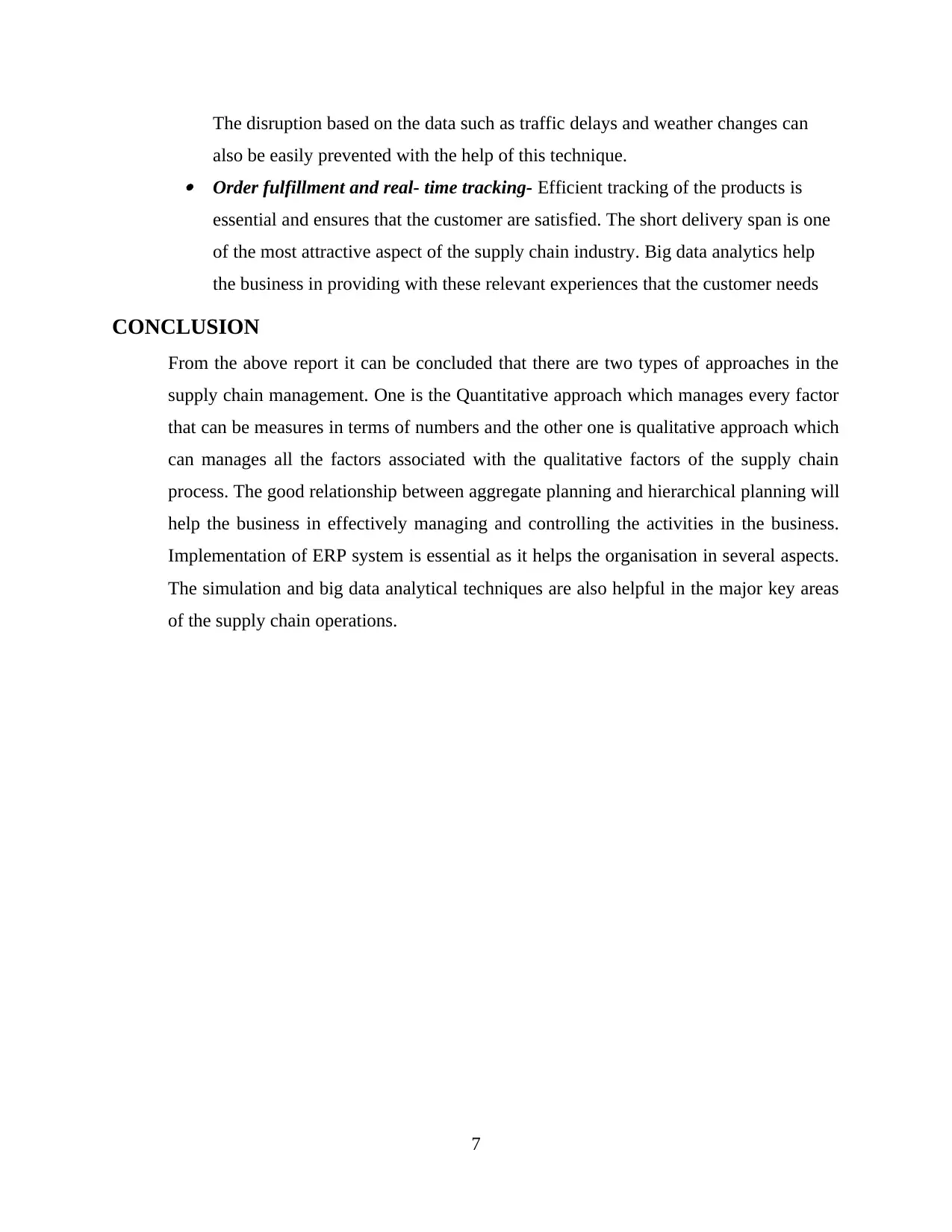
The disruption based on the data such as traffic delays and weather changes can
also be easily prevented with the help of this technique.
Order fulfillment and real- time tracking- Efficient tracking of the products is
essential and ensures that the customer are satisfied. The short delivery span is one
of the most attractive aspect of the supply chain industry. Big data analytics help
the business in providing with these relevant experiences that the customer needs
CONCLUSION
From the above report it can be concluded that there are two types of approaches in the
supply chain management. One is the Quantitative approach which manages every factor
that can be measures in terms of numbers and the other one is qualitative approach which
can manages all the factors associated with the qualitative factors of the supply chain
process. The good relationship between aggregate planning and hierarchical planning will
help the business in effectively managing and controlling the activities in the business.
Implementation of ERP system is essential as it helps the organisation in several aspects.
The simulation and big data analytical techniques are also helpful in the major key areas
of the supply chain operations.
7
also be easily prevented with the help of this technique.
Order fulfillment and real- time tracking- Efficient tracking of the products is
essential and ensures that the customer are satisfied. The short delivery span is one
of the most attractive aspect of the supply chain industry. Big data analytics help
the business in providing with these relevant experiences that the customer needs
CONCLUSION
From the above report it can be concluded that there are two types of approaches in the
supply chain management. One is the Quantitative approach which manages every factor
that can be measures in terms of numbers and the other one is qualitative approach which
can manages all the factors associated with the qualitative factors of the supply chain
process. The good relationship between aggregate planning and hierarchical planning will
help the business in effectively managing and controlling the activities in the business.
Implementation of ERP system is essential as it helps the organisation in several aspects.
The simulation and big data analytical techniques are also helpful in the major key areas
of the supply chain operations.
7
⊘ This is a preview!⊘
Do you want full access?
Subscribe today to unlock all pages.

Trusted by 1+ million students worldwide

References:
Books and Journals
Arifin, M., Ibrahim, A. and Nur, M., 2019. Integration of supply chain management and tourism:
An empirical study from the hotel industry of Indonesia. Management Science
Letters, 9(2), pp.261-270.
Baah, C. and Jin, Z., 2019. Sustainable supply chain management and organizational
performance: the intermediary role of competitive advantage. J. Mgmt. &
Sustainability, 9, p.119.
Baliga, R., Raut, R. and Kamble, S., 2019. The effect of motivators, supply, and lean
management on sustainable supply chain management practices and performance:
Systematic literature review and modeling. Benchmarking: An International Journal.
Darvazeh, S.S., Vanani, I.R. and Musolu, F.M., 2020. Big data analytics and its applications in
supply chain management. New Trends in the Use of Artificial Intelligence for the
Industry 4.0, p.175.
El Baz, J., Laguir, I. and Stekelorum, R., 2019. Logistics and supply chain management research
in Africa: A systematic literature review and research agenda. The International Journal
of Logistics Management.
Mathivathanan, D., Kannan, D. and Haq, A.N., 2018. Sustainable supply chain management
practices in Indian automotive industry: A multi-stakeholder view. Resources,
Conservation and Recycling, 128, pp.284-305.
Oelze, N., Gruchmann, T. and Brandenburg, M., 2020. Motivating factors for implementing
apparel certification schemes—a sustainable supply chain management
perspective. Sustainability, 12(12), p.4823.
Sarkis, J. and Dou, Y., 2017. Green supply chain management: A concise introduction.
Routledge.
Tseng, M.L., and et. al.,2020. Sustainable supply chain management in stakeholders: supporting
from sustainable supply and process management in the healthcare industry in
Vietnam. International Journal of Logistics Research and Applications, pp.1-20.
Waller, M.A., and et. al., 2019. Integrating blockchain into supply chain management: A toolkit
for practical implementation. Kogan Page Publishers.
Waters, C.D.J., 2019. Logistics: an introduction to supply chain management. Red Globe Press.
Wu, J.Z., Santoso, C.H. and Roan, J., 2017. Key factors for truly sustainable supply chain
management: An investigation of the coal industry in Indonesia. The International
Journal of Logistics Management.
8
Books and Journals
Arifin, M., Ibrahim, A. and Nur, M., 2019. Integration of supply chain management and tourism:
An empirical study from the hotel industry of Indonesia. Management Science
Letters, 9(2), pp.261-270.
Baah, C. and Jin, Z., 2019. Sustainable supply chain management and organizational
performance: the intermediary role of competitive advantage. J. Mgmt. &
Sustainability, 9, p.119.
Baliga, R., Raut, R. and Kamble, S., 2019. The effect of motivators, supply, and lean
management on sustainable supply chain management practices and performance:
Systematic literature review and modeling. Benchmarking: An International Journal.
Darvazeh, S.S., Vanani, I.R. and Musolu, F.M., 2020. Big data analytics and its applications in
supply chain management. New Trends in the Use of Artificial Intelligence for the
Industry 4.0, p.175.
El Baz, J., Laguir, I. and Stekelorum, R., 2019. Logistics and supply chain management research
in Africa: A systematic literature review and research agenda. The International Journal
of Logistics Management.
Mathivathanan, D., Kannan, D. and Haq, A.N., 2018. Sustainable supply chain management
practices in Indian automotive industry: A multi-stakeholder view. Resources,
Conservation and Recycling, 128, pp.284-305.
Oelze, N., Gruchmann, T. and Brandenburg, M., 2020. Motivating factors for implementing
apparel certification schemes—a sustainable supply chain management
perspective. Sustainability, 12(12), p.4823.
Sarkis, J. and Dou, Y., 2017. Green supply chain management: A concise introduction.
Routledge.
Tseng, M.L., and et. al.,2020. Sustainable supply chain management in stakeholders: supporting
from sustainable supply and process management in the healthcare industry in
Vietnam. International Journal of Logistics Research and Applications, pp.1-20.
Waller, M.A., and et. al., 2019. Integrating blockchain into supply chain management: A toolkit
for practical implementation. Kogan Page Publishers.
Waters, C.D.J., 2019. Logistics: an introduction to supply chain management. Red Globe Press.
Wu, J.Z., Santoso, C.H. and Roan, J., 2017. Key factors for truly sustainable supply chain
management: An investigation of the coal industry in Indonesia. The International
Journal of Logistics Management.
8
1 out of 10